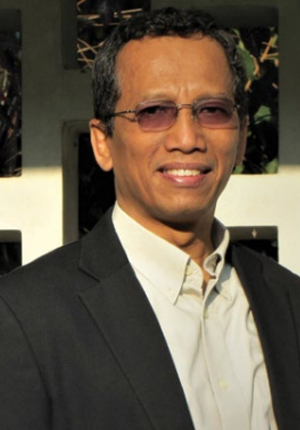Healing the Past
On the edge of Chuuk Lagoon, a sandy atoll in Micronesia, a young Jesuit was summoned to a remote school house.
He was told that the school’s history teacher, an American volunteer, had gone home to Iowa. Would the seminarian from Java put aside his other duties and accept this new assignment? Baskara Wardaya swiftly agreed. History could transport him to many new places, even if Chuuk was in the middle of nowhere. “You can broaden your mind through stories from other people,” he reasoned.
In pivoting toward history, he found a second vocation. After completing his assignment in Chuuk in 1989, he returned to Indonesia and was ordained a priest in 1992. He went on to earn a PhD in history in 2001. Today, the cleric and scholar known as Romo (“Father”) Baskara plays a vital role in encouraging Indonesians to reexamine their nation’s past with both critical thinking and empathy.
With support from Fulbright, the 56-year-old historian has pursued his core interest: probing the relations between the United States and Indonesia to yield a fuller understanding of the geopolitics behind the cataclysmic shift in power from President Sukarno to President Suharto in 1965–1966. A Fulbright grant in 2004–2005 gave him access to primary sources in the library of former US president Lyndon B. Johnson, and to other materials collected at the University of Wisconsin-Madison.
He sought to comprehend the killings of six Indonesian generals in the early morning of October 1, 1965, and the subsequent massacre of accused leftists that claimed up to half a million lives—which left a miasma of fear lingering for half a century. Romo Baskara believes that open discussion of this painful and controversial period is necessary for healing at the grassroots level.
“Most young people are ready for reconciliation,” observes Romo Baskara, head of the Center for History and Political Ethics at Sanata Dharma University in Yogyakarta. In his view, however, many individuals among the older generations—citizens who were 15 years old or more in 1965—are “not quite ready” to reconcile with their neighbors, due in part to a dogmatic historical narrative imposed by Suharto’s New Order government, which branded the banned Communist Party of Indonesia as an insidious force that could rise again at any moment. Suharto was toppled in 1998, providing an opening for books, films, and magazine articles that challenged this version of history. Yet, paramilitary groups continue to rail against a renewed “communist threat,” their warnings conveyed through marches, banners, and ominous phone calls.
Despite this charged political atmosphere, Romo Baskara has calmly and consistently led discussions on the tangled geopolitics of the 1960s and their human cost. In venues ranging from small towns in Java to major university campuses in the United States, he shares his findings from books that he has either written or edited, including Membongkar Super-semar— now in its fourth printing—Bung Karno Menggugat, and Suara di Balik Prahara, which was released in English translation in 2013 as Truth Will Out. His writing is noted for its communicative style, which appeals to a youthful readership.
Romo Baskara extols the use of oral history as an “alternative to the grand, official narratives that are produced and reproduced by those in power.” Truth Will Out includes firsthand accounts from both witnesses and victims of the bloodletting, and describes reactions from the local Catholic Church hierarchy. Anticipating his critics, Romo Baskara writes that the book is not intended to be a “whitewash,” and assures readers that they need not accept all these accounts at face value. Memories can take many forms. The author also suggests that readers need not be “dumbstruck or paralyzed in despair, but rather take steps forward with hope.”
As a priest attuned to human suffering, Romo Baskara brings the same message to personal encounters with Indonesians aching to overcome the stigma of 1965. In meeting them one-to-one or in small groups, he urges them to keep their spirits up, and to make friends by attending meetings of their neighborhood associations (RT/RW) or joining self-help groups (gotong royong). Such modest steps toward community reconciliation can make a big difference, the cleric believes. “Romo has charisma, and when he uses the word ‘hope,’ it is powerful,” says Winarso, coordinator of Sekretariat Bersama ’65, a group in Central Java aimed at helping former prisoners and their families.
Many of the group’s members are Muslim, and Winarso makes it clear that Romo Baskara does not spend his time proselytizing for Catholicism. Recently, in seeking unity, the Jesuit priest persuaded members of the Yogyakarta sultanate to meet with elderly women who were formerly imprisoned, resulting in promises of health benefits.
To find ways to generate more public interest in history, particularly among the youth, Romo Baskara has interacted with comic book artists, novelists, and painters. “What’s very specific about Romo Baskara is his persistence in pursuing this topic,” observes Amrih Widodo, an honorary senior lecturer at Australian National University in Canberra. “Not only is the production of knowledge important, but the circulation and repetition of that knowledge is also important.”
In November 2015, for example, Romo Baskara supported an initiative by fellow Sanata Dharma historian Yerry Wirawan and others to mount an exhibition called Museum Bergerak 1965. Held at the University of Gadjah Mada (UGM) in Yogyakarta, the display included cooking vessels and shoes belonging to former political prisoners who did forced labor on Buru Island. The exhibition drew many young visitors, and no one tried to shut it down.
The topic can stir deep emotion. In June 2015, Romo Baskara followed a filmmaking team to Buru Island, and the trip moved him to tears, recounts researcher Ita Nadia.
Raised in a village near Purwodadi, Central Java, Baskara knew his father to be a staunch supporter of Sukarno and an avid reader of nationalist tomes like Di Bawah Bendera Revolusi, a collection of Sukarno’s speeches. He was a schoolmaster, married to a hardworking woman who raised seven children and got up before dawn to cook for agricultural workers who harvested crops on the family’s land— rice, cassava, peanuts, corn, and soybeans. They were both Catholics. Their village, Rejosari, escaped the violence of 1965. But in 1969, a massacre was carried out in Purwodadi, along with many arrests of alleged leftists. Seven Catholic teachers were reportedly among those detained. The historian says his own family was not affected.
Education was a road out of Rejosari. The Jesuits had always been strong on philosophy and mathematics. But they needed more historians to teach in high schools and universities. In 1993, Romo Baskara left for the United States, with Jesuit funding to pursue a PhD at Marquette University in Wisconsin. He was quickly drawn into a dialogue with Cornell University professors and other academics who vigorously countered Suharto’s version of events. This stoked his motivation to learn more.
For his PhD dissertation, he focused on the administration of former US president Harry Truman, whose fleeting support for Dutch moves to reconquer Indonesia infuriated nationalists. The research resulted in a book, Cold War Shadow: United States Policy toward Indonesia, 1953–1963. A 2004 Fulbright grant enabled him to move on to the Johnson years, from 1963 to 1969. Romo Baskara concluded that the American president, along with officials from the Central Intelligence Agency (CIA), held a distorted view of Sukarno’s leftist stance, ignoring his Javanese bent toward unity between conflicting political forces. They considered him a “pro-communist, proSoviet Union demagogue,” who would not only oppose US economic interests in Indonesia, but would ignite global anti-American sentiment among newly independent nations.
Johnson’s predecessor, President John F. Kennedy, had shown a friendlier face to Sukarno, promising increased economic aid. But his assassination gave the upper hand to players eager to see Sukarno ousted. Much of the 1965 carnage was hushed up domestically and abroad; Johnson and his subordinates took satisfaction in knowing that the Communist Party was eviscerated and a more pro-American leader had seized control, the Jesuit cleric learned.
Under the guidance of University of Wisconsin-Madison historian Alfred McCoy, an expert in CIA history in Southeast Asia, Romo Baskara pored through memos and other intelligence sources. Seven years later, thanks to a second Fulbright grant in 2011–2012, he broadened his knowledge of political conflicts and colonial legacies elsewhere in the region and taught classes in Southeast Asian history at the University of California, Riverside. This also assured him proximity to the libraries of former US presidents Richard Nixon and Ronald Reagan.
Romo Baskara has yet to discover who, exactly, bears the lion’s share of responsibility for the 1965–1966 violence in Indonesia. No library has yielded the ultimate “smoking gun,” he concedes. Along with many fellow historians, he eagerly awaits online access to a cache of US government documents newly declassified in Washington, DC.
At this stage, however, he is inclined to point to multiple sources of violence, rather than focus on a sole mastermind. Choosing a metaphor for 1965, he refers to the Hudson River near Columbia University in New York— the university where he serves on a steering committee for the Alliance for Historical Dialogue and Accountability. “Where does this big Hudson River come from?” asks Romo Baskara.“Not just one source. There are tributaries.” Given so many stories and so many players, this historian predicts that the truth won’t be simple.
Last Updated: Apr 15, 2019 @ 2:43 pm




